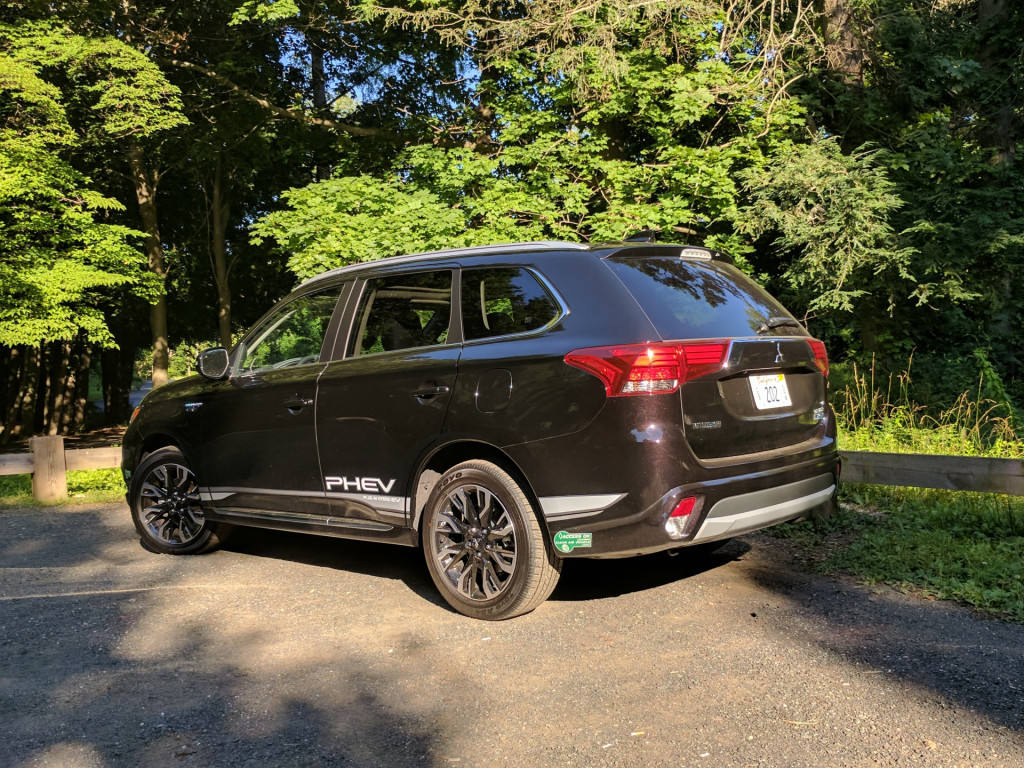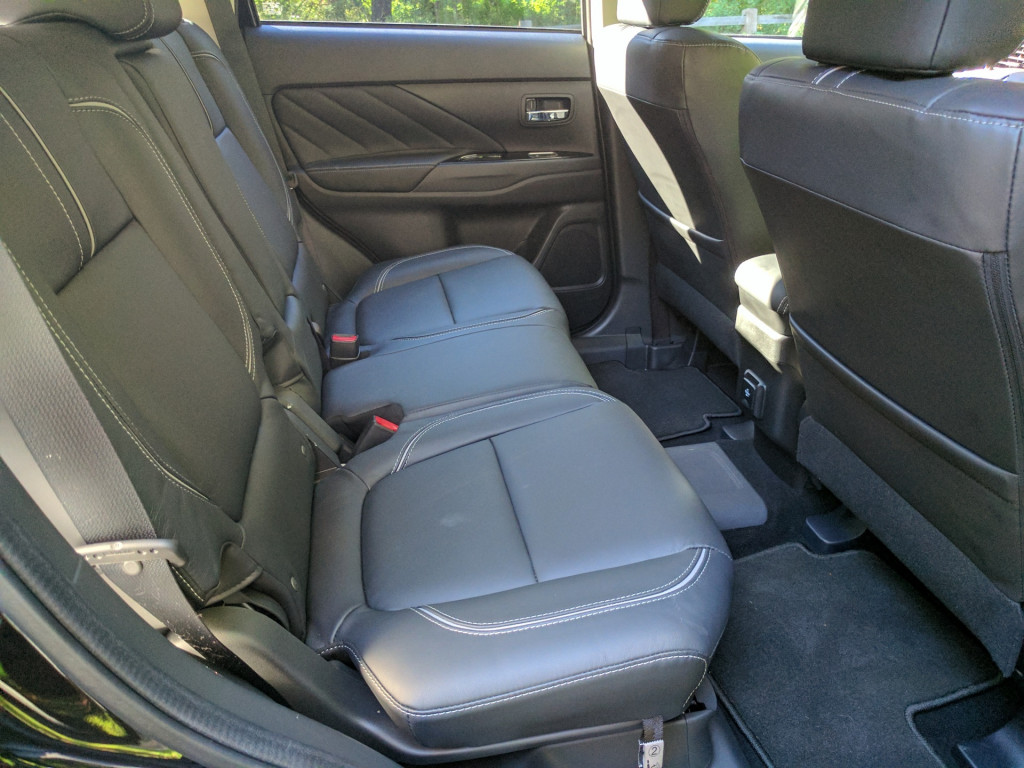The Mitsubishi Outlander plug-in hybrid is something of a missing link in the market for plug-in cars.
There are finally plenty of choices for those who want to dispense with gas entirely and buy a small hatchback. Several electric SUVs are coming, but the only one that really lives up to the automotive ideal of driving anywhere you want at a moment's notice is the $80,000-and-up Tesla Model X with its access to Tesla’s Supercharger network. (Once VW finishes building out its Electrify America network in another six years, other electric SUVs will have similar access.)
With two cars in the prototypical American driveway, many families own at least one SUV (and increasingly two), to cover just about any conceivable need. Most of these SUVs that American families purchase by the millions burn a lot of gas.

2018 Mitsubishi Outlander PHEV
It’s easy for many of those families to see how they could replace one car that does school drop-off and commuter runs with an electric model. It’s that thirsty SUV that gets used on long family trips that’s harder to replace with an electric car.
Enter, finally, the Mitsubishi Outlander PHEV, which has been the bestselling plug-in hybrid in Europe since it debuted there five years ago. It’s not the first plug-in hybrid SUV in the U.S., but it is the first one that’s affordable for most carbuyers.
It delivers 22 miles of range on electricity, which should get a stay-at-home parent, or a grandparent, or even a local working spouse through most of the daily errands they need to accomplish on electricity, without making family trips any more difficult than any other SUV.
READ THIS: Outlanders Inbound: Plug-in Electric Car Sales In Canada, March 2018
In our test, the Outlander PHEV got 34 mpg, even with an empty battery. We traveled roughly 130 miles.
The Outlander PHEV works similarly to the latest Honda hybrids, with a 117-horsepower, 2.0-liter inline-4 set up in series with electric motors driving the wheels. When the engine is running, it can clutch it in to drive the front wheels mechanically at highway speeds, for a total range of 310 miles on gas and electricity.
One 60-kw motor drives the front wheels and another the rear, giving the Outlander PHEV all-wheel drive and 197 total horsepower at the road. With the electric motors’ instant torque, it feels quicker than most other small SUVs.

2018 Mitsubishi Outlander PHEV
A 12-kwh lithium-ion battery pack hangs under the floor. The Outlander PHEV is the only plug-in hybrid on the market in the U.S. with a CHAdeMO quick-charge port, which can recharge the battery to 80 percent in about 25 minutes. On a Level 2 charger at home, we confirmed that it takes about the 3.5 hours that Mitsubishi expects to charge the battery from empty.
What the Outlander PHEV lacks compared with the standard Outlander is a third-row seat. Mitsubishi says the space was needed for the rear motor and the charging system.
CHECK OUT: 2018 Mitsubishi Outlander PHEV: first drive of plug-in hybrid SUV
We had a chance to drive the Outlander PHEV for nine days around rural and suburban Connecticut, and found it mostly lived up to its purpose.
The powertrain does its best to maximize energy efficiency. It has three buttons around the shifter to set modes to maximize electric driving, save battery (and maximize gas driving), and a charge mode that will use the engine to recharge the battery for drivers who get stuck without a charge and need one. That is, of course, the least efficient means of charging the battery and the least efficient way to drive.
The three modes are more suggestions than overrides. Each has a distinct effect, but when we tried battery save mode with two miles of electric range showing on the dashboard indicator, the car went right through it. In EV mode, it took a much deeper dig into the accelerator before the engine would start, but it still did.

2018 Mitsubishi Outlander PHEV
The Outlander PHEV uses the engine only as a generator most of the time when the battery is discharged, and the drivetrain stays remarkably quiet and smooth. Our 34 mpg in a mix of rural road, highway, and a little city driving, was significantly better than the Outlander PHEV’s EPA rating of 25 mpg, and a little better in the conditions than the Toyota RAV4 Hybrid, for example.
Although the Outlander PHEV will start the engine even in “EV priority” mode, as Mitsubishi calls it, and with a full charge in the battery, we found it easy to do most driving on electricity when the battery was charged. To light the gas-burner, you have to deliberately stab the pedal hard or be in a pinch jumping out into traffic.
In our test of EV Mode, the Outlander PHEV went exactly the 22 electric miles that the EPA estimates. For 2019, the Outlander PHEV is scheduled to get a bigger, 13.8-kwh battery that should reach 24 or 25 miles of electric range.
The Outlander PHEV seemed most comfortable and in its element in blended mode (no override buttons selected) with a full charge, when it runs mostly on electricity but will—only if the engine has already started—run on gas on the highway, above about 45 mph, and mostly on electricity below that. In this mode, the battery lasted a hair over 29 miles before the car reverted to hybrid mode. Over the 29 miles, we got 73 mpg, counting only the gas we used. Add in about 9-kwh of electricity that we used from the battery and that drops to about 45 MPGe—still impressive for a small SUV that’s on the large end of the category.

2018 Mitsubishi Outlander PHEV
On the highway, with the battery discharged, the Outlander PHEV will clutch in the engine, even when climbing fairly steep grades at speed, unlike some recent Honda hybrids. It seemed to prefer shifting to this mode when the driver applied some throttle. At light throttle, such as cruising at 55 mph, it often wouldn’t engage the clutch and would run the engine to produce power for the motors like a series hybrid.
No matter what mode we chose, the Outlander’s gas engine remained almost imperceptible most of the time, even with no charge in the battery. Occasionally, when the battery was depleted, the engine would briefly roar to life. The engine’s wail sounds particularly coarse, but never lasted long and wasn't especially loud, just gruff.
Shift paddles behind the steering wheel select among five levels of braking regeneration, but none are as strong as experienced electric-car drivers would probably prefer. We selected B in the Toyota Prius-like shifter when starting out, which sets the regen at a mid-level 3. Then we pulled the left paddle to select 5—every time we started out. Mitsubishi confirmed there is no way to change this default.
Inside, the Outlander PHEV is roomy, with just a slight plateau in the rear footwells to accommodate the batteries.

2018 Mitsubishi Outlander PHEV
Interior materials feel upscale for a small SUV not named Audi or Mercedes. Almost everything is covered in nicely padded, stitched leather, or piano-black plastic.
We found some quibbles with the controls: That Prius-like shifter blocks the view of the Park button; it took us a couple of minutes to find it the first time, but the car will select it automatically when you turn the power off.
The icons and menu structure in the center touchscreen look cheap and take way too many swipes across different screens to find what you want while you’re driving. It looks and feels like a cheap Android tablet with a volume knob.
Our biggest gripe with the Outlander PHEV is the ride. The rear end bobs over swales and occasionally thuds and trips into mid-turn bumps like a sway-backed horse. It feels like Mitsubishi hung 650 pounds of batteries below the floorboard and didn’t upgrade the suspension (though we’re not saying that’s what actually happened.)

2018 Mitsubishi Outlander PHEV
The base Outlander PHEV SEL starts at $36,115, including destination and handling, with all-wheel drive, leather seats, the touchscreen interface with Android Auto and Apple CarPlay compatibility, and Mitsubishi's 10-year/100,000-mile warranty for the powertrain. It earns a $5,836 federal tax credit that can bring the effective price down to $30,279 for most buyers. That’s a price premium of about $800 over the non-plug-in Outlander, Mitsubishi says.
The Outlander PHEV GT stickers for $41,290 and adds automatic emergency braking, adaptive cruise control, lane-departure warning, automatic high-beams, a panoramic moonroof, Rockford Fosgate premium audio , and a 115-volt power take-off that uses energy from the main battery to power tailgating parties, coffeemakers when camping, power tools, and anything else.
For most families looking to minimize their gas usage, the Outlander PHEV could be a key enabler. It delivers just enough utility and versatility, and had plenty of range to run all our errands easily for a week on electricity. Do we wish it had more? Sure. But not if it meant giving up some of the Outlander’s space, comfort, and functionality. This is a companion car for families transitioning to electric driving, and it fills that role to a T. The only thing we really wish for is a steadier ride.












